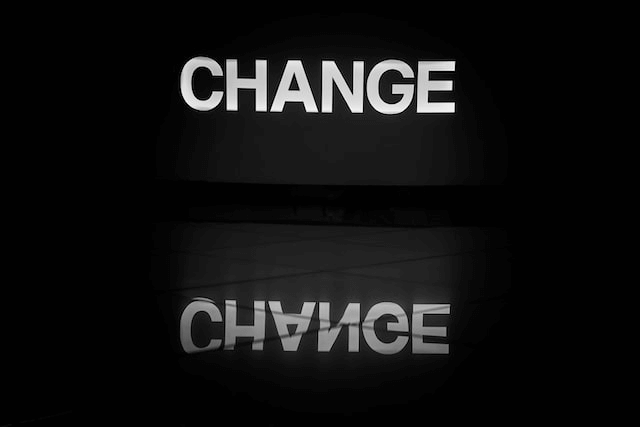Organizational ManagementOrganizational Strategy
Change in the Workplace: What’s good about it?
Change in the workplace often brings up negative connotations. Although change is daunting and frightening, it also moves us out of our comfort zone which inspires innovation. However, change is good, so we explore change in this article, specifically focusing on how change is positive.
Changes come from a number of directions; organic growth, economic environments, political climate, consumer behavior, etc. Wherever it may come from, it is important to manage change so that it does not overwhelm the company culture.
As a headhunter or executive search firm, we’ve seen firsthand the changes that have occurred in the workplace over the years. Change in a company can lead to many positive outcomes. They can give a company a competitive edge and help businesses to remain relevant in their industry. Change improves morale, provides better organizational opportunities, develops skills, and encourages innovation.

Why it’s important to adapt to change in the workplace
Any kind of change, including workplace change, can make us uncomfortable, because routines are interrupted and we are bought out of our comfort zone. Most people become comfortable in their positions and their routines and this makes them resistant to organizational change.
But, when organizational change just does not happen, and the work environment remains the same, however comfortable it may be, companies stagnate. This state of stagnation is the antithesis of growth, and such a company will have great difficulty keeping up with the ever-evolving business climate. Adaptability to change is key to organizational and professional growth.

What happens when companies don’t change?
As we have mentioned before, a lack of change results in stagnation in a business. A stale business environment cannot adapt to new possibilities. It is not an environment that supports new ideas or creativity. This also means that improvement of operations is not possible.

What kind of changes happen in the workplace?
The modern workplace is changing fast. The biggest recent push for change came from the COVID-19 pandemic. Companies had to take serious steps to meet lockdown regulations. Changes to working environments were sudden and extensive, and many companies permanently adopted hybrid work models because they saw how positively the change in the workplace impacted the productivity of their employees.
There are several different types of changes that can impact your work environment.
Mergers and Aquisitions
These occur when a company is either looking to purchase another business or has been purchased by another company. This often leads to a point where staff reduction is required, and the remaining staff will see major changes to their roles.
New Technologies
Digitalization is at an all-time high and has forced many organizations to look into the relationship between technology and employees. The future demands technology to be front and center of business development, and how companies respond to this demand may pave the way to success or to ruin.
Changing Focus on Diversity, Inclusion, and Equity
DEI is more important now than it has ever been before. Many corporations are implementing change management strategies to improve their overall DEI in the workplace in response to the recent emphasis on its importance.
Changing Demographics
Organizational leaders are facing the first time in history where five generations are active in the workplace at the same time. This level of generational diversity has changed many dynamics in the workplace. When employee engagement is high and there is an understanding of the value that multiple generations have in a workplace, there is a drive for innovation and adaptations for the future workplace.
Structural Change
A new organizational structure has been the most prominent change process experienced in the workplace in recent years. Many companies have implemented new procedures that allow employees to work remotely. A hybrid workplace that allows employees to rotate is highly popular as the hybrid model allows employees a lot of flexibility. This can bring big changes to a company’s culture so when leadership wants to implement change at this level it is best to do so with an official change management process.
Change of Government
In some instances, a governmental change might trickle down into the path of organizations and cause some challenges. Especially when the change impacts how a business is currently functioning.
Product Changes
Sometimes, in order to stay competitive, organizations need to change their product. This is often just due to technological advances that might result in a certain product becoming obsolete. For example, walkman-type CD players, or video rental services were a booming industry only twenty years ago, but have since gone out of use due to advances in technology.
When change management is an ongoing aspect of your business strategy, changes will likely happen more organically, and serve to grow your company rather than hurt it. Being able to adapt to organic changes is a strong protective factor in the world of change management.

The positive benefits of change in the workplace
The change process might be necessary for business practices but it is not always embraced by owners, managers, or employees. There are several reasons for this, many related to a desire to remain within their comfort zone. Nonetheless, change in the workplace can have a largely positive impact on organizational success in the long run.
Better Staff Morale
When staff is able to see that their company can adapt to change easily, they are more likely to have a positive outlook on change initiatives. It also helps the employee to view the organization in a positive light.
When a company can manage change effectively, many employees will naturally find that they understand the company is working to create better corporate circumstances for the workforce. This makes buy-in much easier and can lead to more team satisfaction and higher employee satisfaction.
New Business Opportunities
Companies that have the ability to embrace change will never be in short supply of new ideas and opportunities. Where organizational change initiatives are plentiful, a company is empowered to move forward and adapt to achieve better results. New opportunities may include, for example, getting involved with another company, or establishing new communication channels that might lead to increased sales.
People Development
A notably difficult part of managing change is persuading staff to embrace change with a positive attitude. In the end, workers gain more through supporting new strategies and ideas but it can be difficult for them to make that initial shift. Staff who are open to change are valuable to a company because they help to create organic change management through positive communication with coworkers.
Promotes Skills Growth
An organization that allows employees the ability to develop their skills throughout their careers tends to have a well-rounded team. Complex problems are solved faster and more effectively and talented workers are able to remain with the team through internal hiring for new roles because team members are multi-skilled. Where people are allowed to grow and thrive they become more loyal to a company and are less likely to seek opportunities outside of the organization.
Encourages Innovation
An organization that is resistant to change will likely feel the effect most in the form of stagnation. Fewer opportunities for initiatives shift the focus of the company towards the mundane, and the idea of “surviving” overcomes that of growing. When a strategy does not allow for change the company culture will become strained and the organization will be left behind in the face of fast-paced development that has become the global norm.
Conversely, when businesses can adapt with ease they are able to nurture new ideas and reduce stress among their workers by getting ahead of the curve and ensuring better work-life balance. Organizational change allows for growth and this allows organizations to stay on top of the latest trends and on top of the market.

So is managing change worth it?
An organization that values the benefits available through change, who embrace change and get involved with new policies, new initiatives, and fresh ideas, will always stand above the competition.
Managers who implement effective change management and objectives increase staff retention because the team has more faith in their decision-making and feels like their concerns are heard, understood, and addressed by their leaders. Overall, an organization with the right leaders in place, who ensure a good work culture for their team, and who respect and support the needs of the organization when it comes to change, are a valuable asset to their employers.










